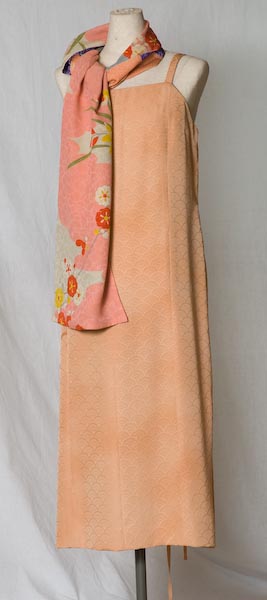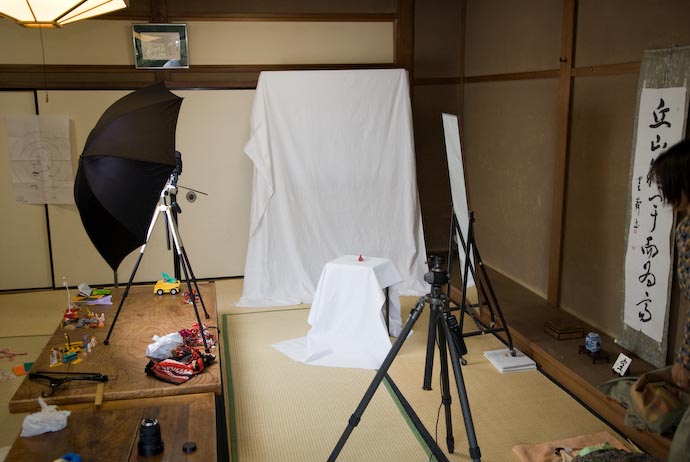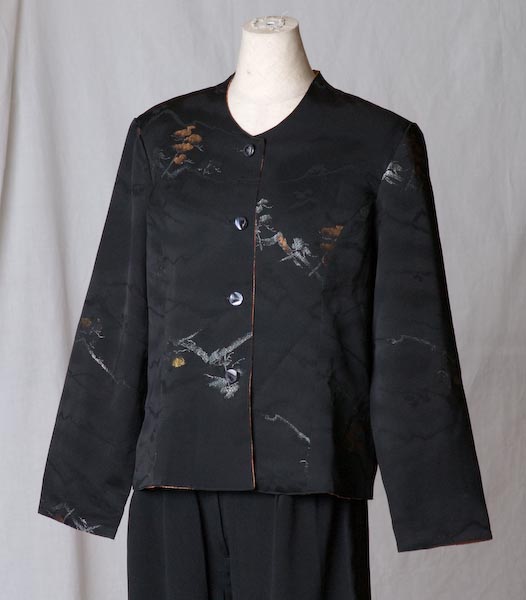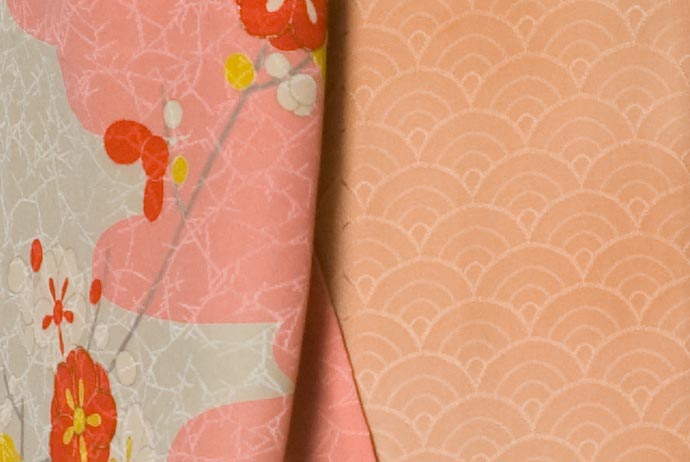
Nikon D200 + Nikkor 85mm f/1.4 — 1/250 sec, f/2.2, ISO 200 — full exif
Silk Shirt: an old Kimono Reborn
I tried my hand at product photography for the first time today, for a Kyoto charity that takes the wonderful silk fabrics from old kimonos and turns them into stylish garments. Ladies in small, rural villages in various south-east Asian countries (Laos, Cambodia, etc.) who have been trained by the charity actually do the sewing, by hand or on pedal-powered sewing-machines provided by the charity. The whole point is to provide people in these small villages a way to earn a living without having to leave their village/family behind.
The charity's name is “Reborn”, which I'd guess refers both to the kimono fabric, and to the vibrancy of the related small villages.
Anyway, as part of helping them to create a web site via which they can market the resulting products, I thought I'd try photographing some of the items.
I've never done product photography, but I know that it's much more difficult than one might think.
I'm sure that it involves a lot of things that I don't know about, but among the things that I know I should know about that I actually know the least about, I know no limit to how little I know about lighting.
I could have used this as an excuse to buy a lot of equipment that I may or may not ever learn how to use, but I started small and bought only a medium-sized flash umbrella (paying here in Kyoto, I see now, exactly twice what it would have cost me in The States) and an adapter that allows me to connect the umbrella and a flash unit to a stand.
I really don't understand the deal with flash/umbrella stands. I could have paid $60 for a short, cheap stand to hold the flash unit, or $8 for an ultra-cheap tripod that folded smaller, set up larger, and was more stable. In the end, I paid nothing and just used my old cheap tripod to hold the flash and umbrella.
I knew I needed at least an umbrella because I knew I needed to use artificial lighting, and reflecting the flash off of the shiny under-surface of a photography umbrella spreads the light out over a wide area, turning harsh shadows into a pillowy-soft glow.
(For your future reference, “pillowy-soft” is generally considered to be better than “harsh.”)
When photographing static products, I'd guess it's nice to have a clean, uneventful background, so I took a big white cloth that I found being used as a dust cover over some boxes, and threw it over a rolling whiteboard. That became my background.
Here's a shot I took of the setup, after I was all done:
That's the setup I used for photographing some small jewelry pouches, which were placed on the cloth-covered box in the center. For photographing the clothes, the tripod was set up much further back, outside the room in a hallway, so that I could get the maximum distance between the camera and the mannequin, and between the mannequin and the background. The further behind the target the background is placed, the more out-of-focus the background becomes, and hence, more “uneventful.”
The flash umbrella is on the table (along with a bunch of toys — Anthony was with me), and my Nikon SB-800 flash unit was set up inside, facing the umbrella so that the target was bathed in the reflected light. The SB-800 was in slave mode, while my Nikon D200's flash was in commander mode, at 1/128th power. (It was at that low power so that its light didn't contribute to the image.)
I used my Nikon D200 and my Nikkor 85mm f/1.4 for all the shots, at 1/60th second at ISO 200. For a while I shot at f/2.2 or f/2.8, using the relatively wide aperture to enhance the out-of-focusness of the background.
After a while, I realized that I was having trouble ensuring everything was in focus, so I switched to f/4.5 to increase the depth of field, at the risk of making the background a more impactful part of the image.

Nikon D200 + Nikkor 85mm f/1.4 — 1/60 sec, f/2.8, ISO 200 — full exif
Close-up Crop to Show the Fabric
I took shots of about 50 items, and after this little bit of experience, I have a small list of things I'd do differently next time.
The first would be to work on the background, since it's too dark and too busy in many of these shots. One method would be to buy a real studio backdrop cloth and stand, but I'd have no way to transport or store such large items, so the other practical approach would be to place a flash behind the mannequin, facing the backdrop. This would eliminate shadows on the backdrop, and make it brighter so that hopefully it just disappeared as a sheet of pure white.
Another thing I'd do is bring a large-high-contrast focus target to make focusing easier. I had a hard time focusing with many of the fabrics, even with the benefits of the Katz Eye I installed last summer. This is one case where a new D3/D300 would have a big impact, since you can use their new zoomed live-preview move effortlessly achieve absolutely perfect focus.
It was particularly challenging to photograph dark fabrics. I had to boost the exposure compensation on the next one to get reasonable results. Unfortunately, that also increased the harshness of the background shadows.
Some were a challenge to “dress” in a way that showed them well. The light jacket below, shown over a dark shirt, looks in my photo more like something from L.L. Bean or an outdoorman's shop than the high-class, elegant wrap it was.
Long dresses were really difficult because I had to move them further from the camera to get them to fit into the frame, which pushed them right up against the backdrop.

1/60 sec, f/4.5, ISO 200 — full exif | 
1/60 sec, f/4.5, ISO 200 — full exif |
All in all it was fun, and the results, while no where near professional, were good enough for now.







Hi Jeffrey,
I enjoy reading your blog.
Nice try. It’s not as easy at it looks, I know. I have tried with shooting shoes, and the results are … not so good 🙂
A hint: You write that > The SB-800 was in slave mode, while my Nikon D200’s flash was in commander mode, at 1/128th power. (It was at that low power so that its light didn’t contribute to the image.)
Using the D200 as CLS Commander (e3 menu) you can set the built-in flash to not contribute at all to the image. Instead of setting it to 1/128th in Manual, you can use the — mode. (You toggle between the M/TTL/– modes using the up/down keys). Check the manuals, as you need to activate CLS (not just “optical slave”) on your SB-800 as well.
Watch out! Playing with flashes and the Nikon CLS is addictive 🙂
Cheers,
Mikkel
Doh, now that you mention it, I knew about the “–” at one point in the past. Must. Read. Manual…. —Jeffrey
Might just be pedantic/nit oriented me, but the creases in the background white fabric (cotton?) kept unsettling me.
Me too, which is why I said that the first thing I’d work on next time is the background. —Jeffrey
Perhaps some steam or a smoother flowing fabric is in order?
Hi Jeffrey,
I have some little experience in photographing small products. One example is my watch.
First as you mentioned already you should get a better background. First of all I would use paper instead of cloth. Paper has no crinkles and reflects the light better. The problem is the size of your subjects. Such really big sheets of paper are not cheep. Additionally you need to lit your background so another flash is required.
Second, put your umbrella closer to the subject. The soft shadows are a function of light source area and distance between light source and subject. Bigger area and smaller distance is softer.
Third, I would personally use a soft box rather than a umbrella. But again your problem is the subject size. You need a soft box minimum the size of your subject.
Regarding your metering. I would do all things manual. The light needed for dark cloth is no other than for light ones. You have the time to do all things manual and if once set you can leave it. Than I would use a shorter shutter speed to avoid camera shake and natural light. You can use 1/250s your sync speed. It doesn’t matter for the flash exposure.
Greetings from Germany
Alex
Thanks for your comments, Alex. That’s a handsome watch, and a very nice photo of it. About the umbrella vs. softbox issue, I didn’t realize it until I was writing up my post, but it turns out that my umbrella can convert into a pass-through (it has a black covering that can be taken off), so I can actually use it like a softbox. Perhaps the umbrella shape lends itself to a larger fill area? About the shutter sync speed, I really do need to learn how to use the flash. I was browsing through the manual today, and, well, I realize even more that I have no clue about flash-photography. —Jeffrey
One other thought: After figuring out the focusing issue mentioned, really work on getting the background well outside the focal range. Use a shorter lens, and open it up to minimize the depth of field. 85mm (* 1.5) is not helping the depth equation. The background material/lighting might become less of an issue.
Personally, I like the neutral gray effect of your background because it directs the eye to the highlights in the product rather than making them feel washed inside an overexposed background. To some extent, it’s a matter of style and production demands. But the pros probably use the later technique for simplicity; it’s easier to wash the background than to deal with correct exposure of the subject AND the background (plus consistency of the background).
~john
Jeffrey, a good source for flash photography is strobist.com. Its mainly a blog, but they have also many static tips and tricks pages.
Regarding your light through umbrella. I think it is not the same as a soft box. The key thing about a soft box is, that the light travels many times forth and back inside. You have basically a box with reflecting material inside and some cloth or semi-transparent paper over it. Mostly you have another layer of cloth inside (at half height) so that the light would reflect back inside and goes forth and back. The result is, that the light comes out of your soft box in every possible angle. And so it is the opposite of direct parallel harsh light.
If you use a reflecting umbrella, you have also different light angles, but the light does not travel back and forth to get additional angles. If you use a light through umbrella, you have the softening effect of the umbrella material, but again the light goes not back and forth.
Here I have a wine glass and a eau de toliette taken with my soft box. At the glass you can see, that there are no harsh flash hightlights and absolutely no shadow behind. The background is also grey (in the glass photo), because I used only one soft box with one SB-800 and no additional flash for the background.
My soft box is a DIY (do it yourself) one. I simply used a big shipping box, but some reflecting material inside and a sheet of semi-transparent paper in front (and one in the middle). It costs me 5 Euro or so. I simply stick my SB-800 in a hole in the back of the box. Sadly I have no pictures of it. Maybe I should blog something about it.
Regarding shutter speed at flash use. You can try the following: Go in a dark place (without enough natural light). Put all things into manual. ISO 100, some aperture (maybe f4) and 1/250s. Use your flash on camera and put it also in manual mode. Photograph some wall or so (does not matter). Adjust the flash power so that the exposure is right. Than lower the shutter speed by one stop (1/125s) – nothing should be different. Than by 2 stop – again nothing happens with your exposure. You can even try 1 second – if you have not much natural light, you exposure would be the same regardless of the shutter speed. So shutter speed does not matter for flash. You can use this fact quite well at product photography. You can work without a tripod (if you like) at 1/250s (I can even go up to 1/500s with my D70s) you will not have any camera shakes.
Alex
While it’s obviously not the best solution, for shots you’ve already taken, it isn’t that hard to PhotoShop the wrinkles away from the background
Hi Jeffrey,
On the subject of lighting, lately the prose has outshone the photo.
Enjoying your stuff as always.
Hah, I’m not sure whether that’s a compliment for my writing or a critical comment on my photos, but since I’ve been a (good?) writer longer than I’ve been trying to be a good photographer, probably the latter. Usually, photos on my blog are merely accessories to whatever story I’m telling; it’s only the rare “wow, look at this photo” post (such as my desktop backgrounds) that I think are actually good. —Jeffrey
Cheers
I’ve seen that salutation before! 🙂